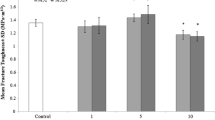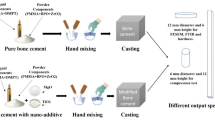Abstract
Analysis of acoustic emission signals generated during the fatigue testing of core–shell nanoparticles filled acrylic bone cements is reported. Core–shell nanoparticles composed of a poly(butyl acrylate) rubbery core and a poly(methyl methacrylate-co-styrene) (P(MMA-co-St)) outer glassy shell with varying compositions (20/80, 30/70, 40/60, and 50/50) were incorporated into the solid phase of bone cement at 10 wt%. Acoustic emission data revealed that the damage accumulation process was discontinuous for all bone cement formulations, being less pronounced in formulations with higher fatigue resistance (20/80 and 30/70) which emitted a higher number of events before the final fracture. The capability of both 20/80 and 30/70 core–shell nanoparticles to hinder the microcracks or crazes propagation was attributed to their poor interfacial adhesion with the matrix in comparison with formulations with 40/60 and 50/50 core–shell nanoparticles. Based on the acoustic emission data and SEM micrographs, a crack propagation scheme for bone cements containing core–shell nanoparticles was proposed. In this regard, core–shell nanoparticles had a double role on the bone cement as reported for other systems; firstly, the nanoparticles promoted nucleation sites for crazes or microcracks, and secondly, they could also hinder the propagation of these defects, acting as a barrier to their growth. Crack propagation mechanism consisted mainly in crazing ahead of the cracks tip as well as the coalescence of these cracks which were responsible of the acoustic emission detected.








Similar content being viewed by others
References
Hailer NP, Garellick G, Kähorrlm J (2010) Uncemented and cemented primary total hip arthroplasty in the Swedish Hip Arthroplasty Register. Acta Orthop 81:34–41
Jeffers JRT, Browne M, Lennon AB, Prendergast PJ, Taylor M (2007) Cement mantle fatigue failure in total hip replacement: experimental and computational testing. J Biomech 40:1525–1533
Hellier C (2003) Handbook of nondestructive evaluation. Chapter 10 acoustic emission testing. McGraw-Hill, New York, pp 10.1–10.39
Roques A, Browne M, Thompson J, Rowland C, Taylor A (2004) Investigation of fatigue crack growth in acrylic bone cement using the acoustic emission technique. Biomaterials 25:769–778
Ng ET, Qi G (2001) Material fatigue behavior characterization using the wavelet-based AE technique—a case study of acrylic bone cement. Eng Fract Mech 68:1477–1492
Jeffers JRT, Browne M, Taylor M (2005) Damage accumulation, fatigue and creep behaviour of vacuum mixed bone cement. Biomaterials 26:5532–5541
Sinnett-Jones PE, Browne M, Moffat AJ, Jeffers JRT, Saffari N, Buffiere JY, Sinclair I (2009) Crack initiation processes in acrylic bone cement. J Biomed Mater Res A 89A:1088–1097
Gutiérrez-Mejía A, Herrera-Kao W, Duarte-Aranda S, Loría-Bastarrachea MI, Canché-Escamilla G, Moscoso-Sánchez FJ, Cauich-Rodríguez JV, Cervantes-Uc JM (2013) Synthesis and characterization of core-shell nanoparticles and their influence on the mechanical behavior of acrylic bone cements. Mater Sci Eng C Mater Biol Appl 33:1737–1743
Pacheco-Salazar OF, Wakayama S, Sakai T, Ríos-Soberanis CR, Cervantes-Uc JM (2015) Evaluation of damage progression and mechanical behavior under compression of bone cements containing core-shell nanoparticles by using acoustic emission technique. J Mech Behav Biomed Mater 46:137–147
Graham J, Pruitt L, Ries M, Gundiah N (2000) Fracture and fatigue properties of acrylic bone cement. The effect of mixing method, sterilization treatment, and molecular weight. J Arthroplasty 15:1028–1035
Jeffers JRT, Browne M, Roques A, Taylor M (2005) On the importance of considering porosity when simulating the fatigue of bone cement. J Biomech Eng 127:563–570
Lewis G, Janna S (2003) Effect of test specimen cross-sectional shape on the in vitro fatigue life of acrylic bone cement. Biomaterials 24:4315–4321
Vila MM, Ginebra MP, Gil FJ, Planell JA (1999) Effect of porosity and environment on the mechanical behavior of acrylic bone cement modified with acrylonitrile-butadiene-styrene particles: I. Fracture toughness. J Biomed Mater Res (Appl Biomater) 48:121–127
Paul DR, Bucknall CB (1999) Polymer blends, vol 2., Performance. Wiley, New York, pp 137–175
Lazzeri A, Bucknall CB (1993) Dilatational bands in rubber-toughened polymers. J Mater Sci 28:6799–6808. doi:10.1007/BF00356433
Ishiyama C, Sakuma T, Shimojo M, Higo Y (2002) Effects of humidity on environmental stress cracking behavior in poly(methyl methacrylate). J Polym Sci Part B 40:1–9
Marissen R (2000) Craze growth mechanics. Polymer 41:1119–1129
Skibo MD, Hertzberg RW, Manson JA, Kim SL (1977) On the generality of discontinuous fatigue crack growth in glassy polymers. J Mater Sci 12:531–542. doi:10.1007/BF00540278
Acknowledgements
We want to thank Q.I. Santiago Duarte Aranda for the SEM micrographs.
Author information
Authors and Affiliations
Corresponding author
Rights and permissions
About this article
Cite this article
Pacheco-Salazar, O.F., Wakayama, S., Sakai, T. et al. Damage accumulation studied by acoustic emission in bone cement prepared with core–shell nanoparticles under fatigue. J Mater Sci 51, 5635–5645 (2016). https://doi.org/10.1007/s10853-016-9865-z
Received:
Accepted:
Published:
Issue Date:
DOI: https://doi.org/10.1007/s10853-016-9865-z




